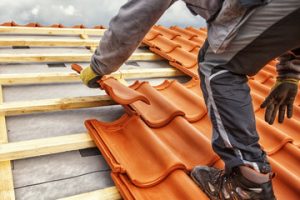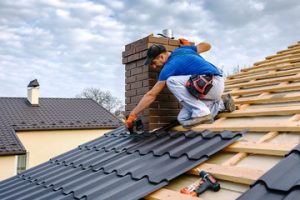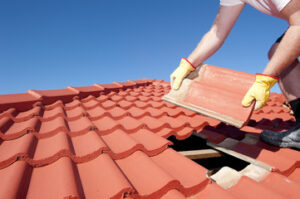The roof is one of the most important parts of your home or business. Regular inspections and maintenance ensure it remains in good condition and protects the structure from the elements.

Roof Repair Massachusetts is typically less costly than replacement, and extend the life of your roof. However, a thorough roof repair can also address hidden issues that could lead to additional damage and expense down the road.
Leaks can be a big problem for homeowners, and they often require professional repair services. If left unattended, water can cause significant damage and affect the interior of your home. Moisture also promotes the growth of mold and mildew, which can pose a health hazard to your family.
If you suspect you have a leak in your roof, it’s important to find the source as quickly as possible. You can do this by observing stains on your ceiling or walls and by listening for the sound of dripping water during rainstorms.
Once you’ve identified a potential source, you can start to narrow down your options for roof leak repair. You’ll need to have a good ladder and safety equipment, such as a hard hat, goggles, gloves, and a caulking gun. Before you begin, make sure that the weather is clear and that there are no other sources of water entering your home.
One common reason for a roof leak is the age or condition of the flashing. This is a thin strip of metal that helps keep water out of vulnerable areas like chimneys, vent pipes, and skylights. Heavy storms or wind can damage flashing, causing it to crack and let water in. If the flashing is old or damaged, it may be necessary to replace it.
Other causes of roof leaks include cracked shingles, improper installation of skylights or roof vents, and broken or missing gutters. It’s also important to regularly clean your gutters to prevent clogging, which can lead to pooling water on the roof.
If you have a lot of tree branches and other debris overhanging your roof, it can block the flow of rainwater. This can cause water to accumulate in a small area on the roof and eventually leak into the home.
If your current roof leak repair is not working, it might be time to hire a professional roofing contractor to perform a full inspection and make repairs. If you aren’t comfortable crawling around on the roof, hiring a professional is the best way to get a quick and reliable repair.
Damaged Shingles
A roof that is free of damaged shingles is essential to keeping your home safe and protected. If left unchecked, shingle damage can lead to water leaks that threaten the integrity of your home’s structure and interior. Addressing shingle issues promptly prevents further damage and saves money compared to a complete roof replacement.
A well-maintained roof is a key part of maintaining or increasing the value of your property. A dingy or damaged roof detracts from the overall curb appeal and may turn off potential buyers. In addition to boosting your home’s value, timely roof repair and maintenance can keep your family and belongings safe and comfortable.
In general, most shingle repair is a fairly straightforward task for homeowners with a little experience and basic tools. The most important tool is a ladder that allows you to safely reach your roof. You’ll also need a flat pry bar and a hammer for driving nails and a utility knife for trimming or cutting shingles if necessary. Lastly, you’ll need roofing nails and replacement shingles that match your existing roof as closely as possible.
The most common sign of a shingle problem is visible damage to the outer layer. Typically, a shingle will lose some of its granules over time due to exposure to extreme weather conditions. When granules lose their protective properties, the asphalt layer beneath becomes exposed and susceptible to leaks and other deterioration.
Other signs of shingle problems include buckling, curling, or breaking. These issues allow moisture to seep under the shingles and into the interior of your home, potentially damaging insulation and causing rot. Leaks and other shingle damage can also occur when tree branches or other debris fall onto your roof during storms.
When identifying shingle problems, it’s best to consult with a professional roofer as early as possible. They will be able to provide an accurate assessment and recommend any necessary repairs. It’s also a good idea to conduct visual inspections of your roof regularly. By conducting these inspections, you can catch shingle damage early and avoid costly roof repair later on.
Flashing
When you have a leaky roof, it can damage the interior of your building and cause serious problems. Roofing professionals use flashing as part of a weather-resistant barrier system to prevent water penetration at seams and joints. Flashing is made from durable materials like metals and plastics and is installed at points of penetration or intersection in a roof. It forms a seal around penetrations such as chimneys, skylights and pipes.
If your roof is showing signs of leaking or has been damaged by the elements, it’s time to call for a professional inspection. A roofing expert will locate the source of the problem and make repairs to stop the leak. This may include removing and replacing damaged shingles or repairing flashing.
Flashing is also used to protect areas where a roof meets a wall. It’s important to have flashing in these areas because they are the most vulnerable to water damage. This can be caused by the buildup of snow or ice or because the materials in these areas are more porous than other parts of the roof. Flashing can be a simple L-shaped piece of metal or it can be more elaborate, such as the “Z” flashing you see on chimneys and some walls. To install Z flashing, the first step is to find a spot on your wall where the upper leg of the flashing will terminate. Next, snap a line with a level or tape measure across the gap from where the ledger board, trim or siding ends to where the wall starts. Then, using a pair of pliers or other tool with sharp jaws, bend the flashing to fit over this area. You can add caulk or another waterproof material to the joint for added protection.
There are also specialty types of flashing for areas such as peaks and corners. These may require special materials or a different installation process. A professional roofer can help you determine which flashing is right for your needs and will provide the correct type and method of installation. In addition, they can advise you on how to properly maintain your flashing to extend its lifespan.
Roof Deck
While your roof shingles and tiles help protect the structure of your home, your roof deck is what keeps water out. It also helps moderate moisture levels in your home by allowing rain and snow to evaporate through the attic. If your roof deck becomes damaged, it can cause a wide variety of problems.
One common problem that can affect your roof deck is rot. This is the result of extended contact with moisture, which can be caused by a variety of factors, including an improperly installed roof, leaks, and natural weather patterns. If left unchecked, rot can spread to the framing and other parts of your home, creating structural damage and mold growth.
Other issues that can impact your roof deck include sun damage, leaks, and moss or mildew. Inspecting your roof every season is a good way to spot these problems before they get out of hand.
A damaged roof deck can lead to a number of other problems, from visible sagging of the ceiling to serious structural damage. A damaged deck can also make it difficult to install shingles or other roofing materials, which will further weaken the overall structure of your roof.
Depending on your location, you may need a permit for any work done on your roof, especially when removing existing shingles or outer roofing materials. It’s also important to follow all safety guidelines when working on your roof, including wearing hard hats and using fall protection.
When replacing the roof deck, it’s important to use plywood or OSB roof decking, along with a proper layer of underlayment, to ensure the integrity of your roof. It’s also important to replace the shingles or other roofing material that was originally in place if necessary.
It’s also a good idea to inspect the rafters and trusses underneath your roof before starting any work. Any damaged or rotten sections should be repaired or replaced before attempting to install any new roofing materials. During this inspection, it’s important to ensure that the rafters and trusses are aligned properly and spaced according to building codes.



